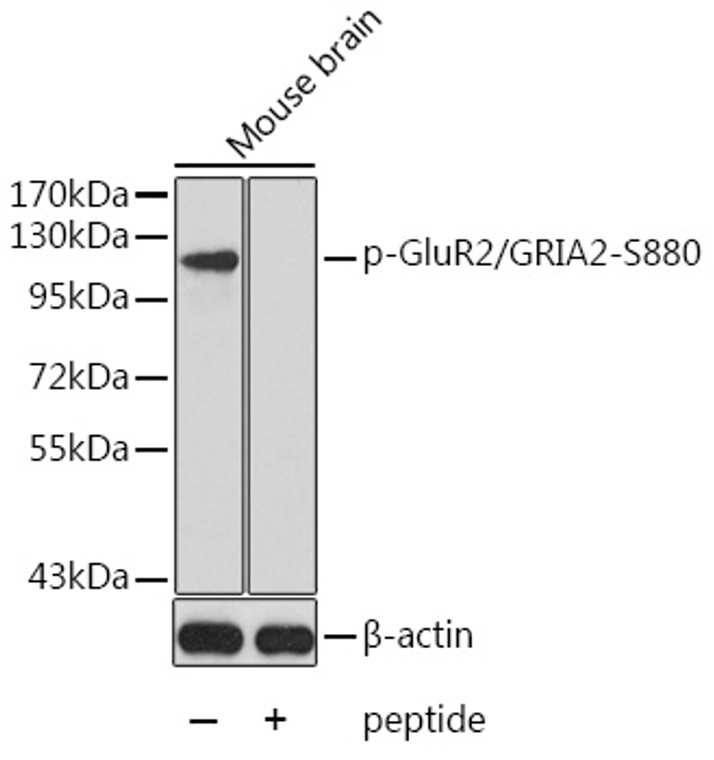| Host: |
Rabbit |
| Applications: |
WB |
| Reactivity: |
Human/Mouse/Rat |
| Note: |
STRICTLY FOR FURTHER SCIENTIFIC RESEARCH USE ONLY (RUO). MUST NOT TO BE USED IN DIAGNOSTIC OR THERAPEUTIC APPLICATIONS. |
| Short Description: |
Rabbit polyclonal antibody anti-Phospho-GRIA2-S880 is suitable for use in Western Blot research applications. |
| Clonality: |
Polyclonal |
| Conjugation: |
Unconjugated |
| Isotype: |
IgG |
| Formulation: |
PBS with 0.02% Sodium Azide, 50% Glycerol, pH7.3. |
| Purification: |
Affinity purification |
| Dilution Range: |
WB 1:500-1:2000 |
| Storage Instruction: |
Store at-20°C for up to 1 year from the date of receipt, and avoid repeat freeze-thaw cycles. |
| Gene Symbol: |
GRIA2 |
| Gene ID: |
2891 |
| Uniprot ID: |
GRIA2_HUMAN |
| Immunogen: |
A phospho specific peptide corresponding to residues surrounding S880 of human GluR2/GRIA2 |
| Immunogen Sequence: |
Email for sequence |
| Post Translational Modifications | Palmitoylated. Depalmitoylated upon glutamate stimulation. Cys-610 palmitoylation leads to Golgi retention and decreased cell surface expression. In contrast, Cys-836 palmitoylation does not affect cell surface expression but regulates stimulation-dependent endocytosis. Phosphorylation at Tyr-876 is required forc interaction with IQSEC1 and ARF6 activation. Ubiquitinated by RNF167, leading to its degradation. |
| Function | Receptor for glutamate that functions as ligand-gated ion channel in the central nervous system. It plays an important role in excitatory synaptic transmission. L-glutamate acts as an excitatory neurotransmitter at many synapses in the central nervous system. Binding of the excitatory neurotransmitter L-glutamate induces a conformation change, leading to the opening of the cation channel, and thereby converts the chemical signal to an electrical impulse. The receptor then desensitizes rapidly and enters a transient inactive state, characterized by the presence of bound agonist. In the presence of CACNG4 or CACNG7 or CACNG8, shows resensitization which is characterized by a delayed accumulation of current flux upon continued application of glutamate. Through complex formation with NSG1, GRIP1 and STX12 controls the intracellular fate of AMPAR and the endosomal sorting of the GRIA2 subunit toward recycling and membrane targeting. |
| Protein Name | Glutamate Receptor 2Glur-2Ampa-Selective Glutamate Receptor 2Glur-BGlur-K2Glutamate Receptor Ionotropic - Ampa 2Glua2 |
| Database Links | Reactome: R-HSA-399710Reactome: R-HSA-416993Reactome: R-HSA-438066Reactome: R-HSA-9022699Reactome: R-HSA-9620244 |
| Cellular Localisation | Cell MembraneMulti-Pass Membrane ProteinEndoplasmic Reticulum MembranePostsynaptic Cell MembranePostsynaptic Density MembraneInteraction With Cacng2Cnih2 And Cnih3 Promotes Cell Surface ExpressionDisplays A Somatodendritic Localization And Is Excluded From Axons In Neurons |
| Alternative Antibody Names | Anti-Glutamate Receptor 2 antibodyAnti-Glur-2 antibodyAnti-Ampa-Selective Glutamate Receptor 2 antibodyAnti-Glur-B antibodyAnti-Glur-K2 antibodyAnti-Glutamate Receptor Ionotropic - Ampa 2 antibodyAnti-Glua2 antibodyAnti-GRIA2 antibodyAnti-GLUR2 antibody |
Information sourced from Uniprot.org
12 months for antibodies. 6 months for ELISA Kits. Please see website T&Cs for further guidance








